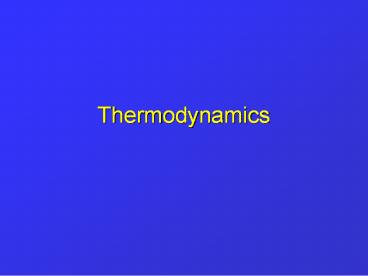Thermodynamics - PowerPoint PPT Presentation
Title:
Thermodynamics
Description:
Thermodynamics Every physical or chemical change is accompanied by energy change Thermodynamics = branch of chemistry that studies energy changes Specifically ... – PowerPoint PPT presentation
Number of Views:254
Avg rating:3.0/5.0
Title: Thermodynamics
1
Thermodynamics
2
Every physical or chemical change is accompanied
by energy change
- Thermodynamics branch of chemistry that studies
energy changes - Specifically changes in heat energy
3
Thermodynamics
- Tells us if a reaction will occur
- 2 considerations
- Enthalpy or energy
- Entropy or chaos
4
Enthalpy, H
- usually do experiments at constant pressure (1
atm) - Enthalpy heat content of a system at constant
pressure - Symbol H
5
Changes in Enthalpy are measurable
- cannot measure enthalpy content of system
directly - can measure changes in enthalpy! Symbol ?H
- ?H Hfinal Hinitial Hproducts - Hreactants
6
Net gain in energy
- Endothermic Process Energy absorbed
- Hfinal gt Hinitial
- so Hfinal Hinitial is positive
- ?H is positive
7
Net loss in energy
- Exothermic Process Energy released
- Hfinal ? Hinitial
- so Hfinal Hinitial is negative
- ?H is negative
- In case you forget the sign of ?H for an
exothermic process, look at the footnote to table
I
8
Which arrow represents an endothermic change?
An exothermic change?
Energy can move between the system and the
environment
9
Change in Energy
- choices in how measure energy change
- depends on how set up experiment
- Monitor the system
- Monitor the environment
- usually easier
10
Energy lost Energy gained
- What tells you that energy has moved?
- can measure energy gained or lost by environment
- it equals energy lost or gained by system
11
The reaction is carried out in the water in the
styrofoam cup The temperature of the water is
monitored
source
12
Q mC?T
- Q Energy change
- m mass of water
- C specific heat of water
- ?T temperature change Tf Ti
13
Different kinds of ?Hs
- ?H on dissolving heat of solution
- ?H on phase change heat of fusion or heat of
vaporization - ?H on reaction heat of reaction
- Categorized by rxn type
14
Look at Table I Heats of Reaction
- Rxns 1-6 combustion rxns ?H
heat of combustion - Rxns 7-18 formation reactions
- Substance is formed from its elements
- ?H heat of formation
- Rxns 19-24 dissolving equations
- ?H heat of solution
15
Energy depends on amount
- Remember it takes more energy to heat up water
in bathtub than to make a cup of tea
16
CH4(g) O2(g) ? CO2(g) 2H2O (l)?H -890.4 kJ
- 1 mole of methane 1 mole of oxygen ?
- 1 mole of carbon dioxide gas 2 moles of liquid
water
reaction is exothermic (negative sign for ?H)
890.4 kJ energy released per mole of CH4(g)
burned
17
Energy depends on amount
- Burn 2 moles of CH4(g) with 2 moles of O2(g), get
2 times as much energy out - Stoichiometry!
- 2 x 890.4 kJ 1780.8 kJ will be released
18
Phase Change Energy depends on direction
Up is endothermic
Down is exothermic
Melting/fusion boiling/ vaporization sublimatio
n
Condensation freezing deposition
19
Reactions Energy depends on direction too!
- N2(g) 3H2(g) ? 2NH3(g) ?H -91.8 kJ
- 2NH3(g) ? N2(g) 3H2(g) ?H 91.8 kJ
- If reverse equation, reverse sign of ?H
20
Hesss Law
- Can add 2 or more equations by adding the ?Hs
- Enables you to calculate ?H for of rxns
- Say youre interested in
- 2S(s) 3O2(g) ? 2SO3(g)
21
2S(s) 3O2(g) ? 2SO3(g)
- Have ?Hs for the following
- a) S(s) O2(g) ? SO2(g) ?H -297 kJ
- b) 2SO3(g) ? 2SO2(g) O2(g) ?H 198 kJ
- Multiply (a) by 2 and reverse (b)
22
Adding
- 2S(s) 2O2(g) ? 2SO2(g) ?H -594 kJ
- 2SO2(g) O2(g) ? 2SO3(g) ?H -198 kJ
- 2S(s) 3O2(g) ? 2SO3(g) ?H -792 kJ
23
Thermochemical Equations
- balanced chemical equation
- shows physical state of all reactants products
- gives energy change (2 ways)
- energy term can be written as reactant or product
- OR
- ?H is given right after equation
24
Exothermic Rxn energy product
- 4Fe(s) 3O2(g) ? 2Fe2O3(s) ?H -1625 kJ
- Or
- 4Fe(s) 3O2(g) ? 2Fe2O3(s) 1625 kJ
25
Endothermic Rxn energy reactant
- NH4NO3(s) ? NH4(aq) NO3-(aq) ?H 27 kJ
-
- Or
- NH4NO3(s) 27 kJ ? NH4(aq) NO3-(aq)
26
Changes of State
- H2O(s) ? H2O(l) ?Hfusion 333.6 J/g at
0oC - H2O(l) ? H2O(s) ?H -333.6 J/g at 0oC
- Energy is released when water freezes!
- H2O(l) ? H2O(g) ?Hvapor 2260 J/g at 100oC
- H2O(g) ? H2O(l) ?H -2260 J/g at 100oC
- Energy is released when water condenses!

